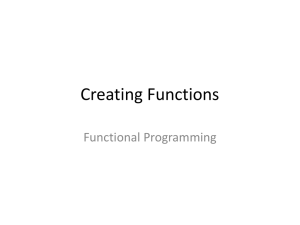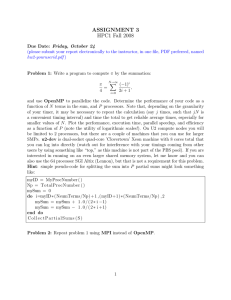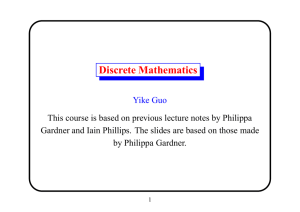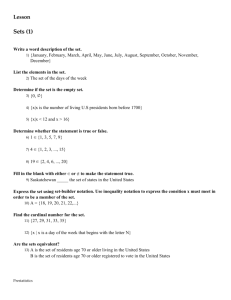CreatingFunctions
advertisement
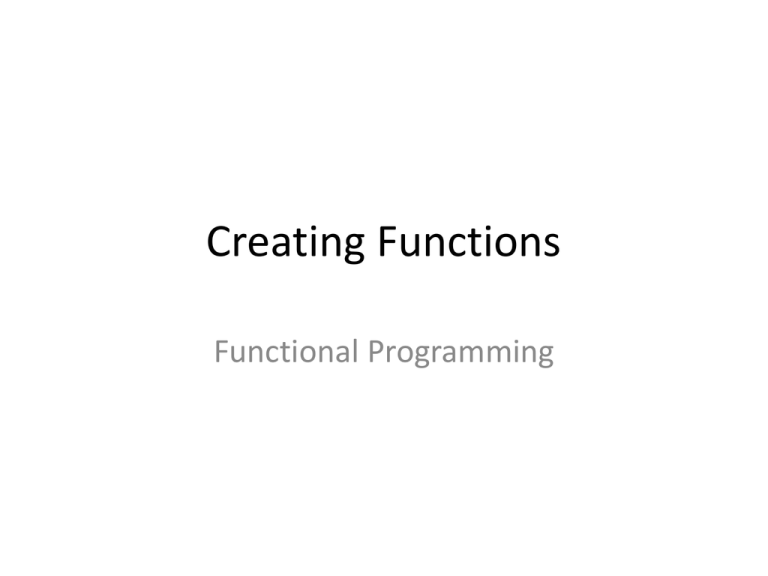
Creating Functions Functional Programming The function calculator • Functional programming is all about using functions • Functions are first class – Take as input, return as result, store in data • A functional language is a function calculator • What buttons do we have for “creating” functions? 12 ways to get a new function • By defining one at top level – By equation – By cases – By patterns • • • • • • • • • By local definition (where and let) By use of a library By lambda expression (anonymous functions) By parenthesizing binary operators By section By currying (partial application) By composition By combinator (higher order functions) By using data and lookup (arrays lists and finite functions) By defining at top level Module Test where plus5 x = x + 5 last x = head(reverse x) CreatingFunctions> plus5 7 12 CreatingFunctions> last [2,3,4] 4 Vertical Bar By cases Equal sign absolute x | x < 0 = -x | x >= 0 = x Name and argument condition Value for case swap (x,y) | x < y = (x,y) | x > y = (y,x) | x==y = (x,y) CreatingFunctions> absolute 3 3 CreatingFunctions> absolute (-4) 4 CreatingFunctions> swap (23,5) (5,23) By patterns • Example on Booleans myand myand myand myand True False = False True True = True False False = False False True = False Pattern may contain constructors. Constructors are always capitalized. True and False are constructors • Order Matters – Variables in Patterns match anything myand2 True True = True myand2 x y = False – What happens if we reverse the order of the two equations above? By local definition (where and let) ordered = sortBy backwards [1,76,2,5,9,45] where backwards x y = compare y x CreatingFunctions> ordered [76,45,9,5,2,1] By use of a Library smallest = List.minimum [3,7,34,1] CreatingFunctions> smallest 1 By lambda expression (anonymous functions) CreatingFunctions> descending [76,45,9,5,2,1] CreatingFunctions> bySnd [[(1,'a'),(3,'a')],[(2,'c')]] descending = sortBy (\ x y -> compare y x) [1,76,2,5,9,45] bySnd = groupBy (\ (x,y) (m,n) -> y==n) [(1,'a'),(3,'a'),(2,'c')] By parenthesizing binary operators six:: Integer -- 1 + 2 + 3 + 0 six = foldr (+) 0 [1,2,3] CreatingFunctions> six 6 By section add5ToAll = map (+5) [2,3,6,1] CreatingFunctions> add5ToAll [7,8,11,6] By partial application Note, both map and any, each take 2 arguments hasFour = any (==4) doubleEach = map (\ x -> x+x) CreatingFunctions> hasFour [2,3] False CreatingFunctions> hasFour [2,3,4,5] True CreatingFunctions> doubleEach [2,3,4] [4,6,8] By composition hasTwo = hasFour . doubleEach empty = (==0) . length CreatingFunctions> [1,3] False CreatingFunctions> [1,3,2] True CreatingFunctions> False CreatingFunctions> True hasTwo hasTwo empty [2,3] empty [] By combinator (higher order functions) k x = \ y -> x all3s = map (k 3) [1,2,3] CreatingFunctions> :t k True k True :: a -> Bool CreatingFunctions> all3s [3,3,3] Using data and lookup (arrays, lists, and finite functions) whatDay x = ["Sun","Mon","Tue","Wed","Thu","Fri","Sat"] !! x first9Primes = array (1,9) (zip [1..9] [2,3,5,7,11,13,17,19,23]) nthPrime x = first9Primes ! x CreatingFunctions> whatDay 3 "Wed" CreatingFunctions> nthPrime 5 11 When to define a higher order function? • Abstraction is the key mysum [] = 0 mysum (x:xs) = (+) x (mysum xs) myprod [] = 1 myprod (x:xs) = (*) x (myprod xs) myand [] = True myand (x:xs) = (&&) x (myand xs) • Note the similarities in definition and in use ? mysum [1,2,3] 6 ? myprod [2,3,4] 24 ? myand [True, False] False When do you define a higher order function? • Abstraction is the key mysum [] = 0 mysum (x:xs) = (+) x (mysum xs) myprod [] = 1 myprod (x:xs) = (*) x (myprod xs) myand [] = True myand (x:xs) = (&&) x (myand xs) • Note the similarities in definition and in use ? mysum [1,2,3] 6 ? myprod [2,3,4] 24 ? myand [True, False] False Abstracting myfoldr op e [] = e myfoldr op e (x:xs) = op x (myfoldr op e xs) ? :t myfoldr myfoldr :: (a -> b -> b) -> b -> [a] > b ? myfoldr (+) 0 [1,2,3] 6 ? Functions returned as values • Consider: k x = (\ y -> x) ? (k 3) 5 3 • Another Example: plusn n = (\ x -> x + n) ? (plusn 4) 5 9 • Is plusn different from plus? why? – plus x y = x + y
